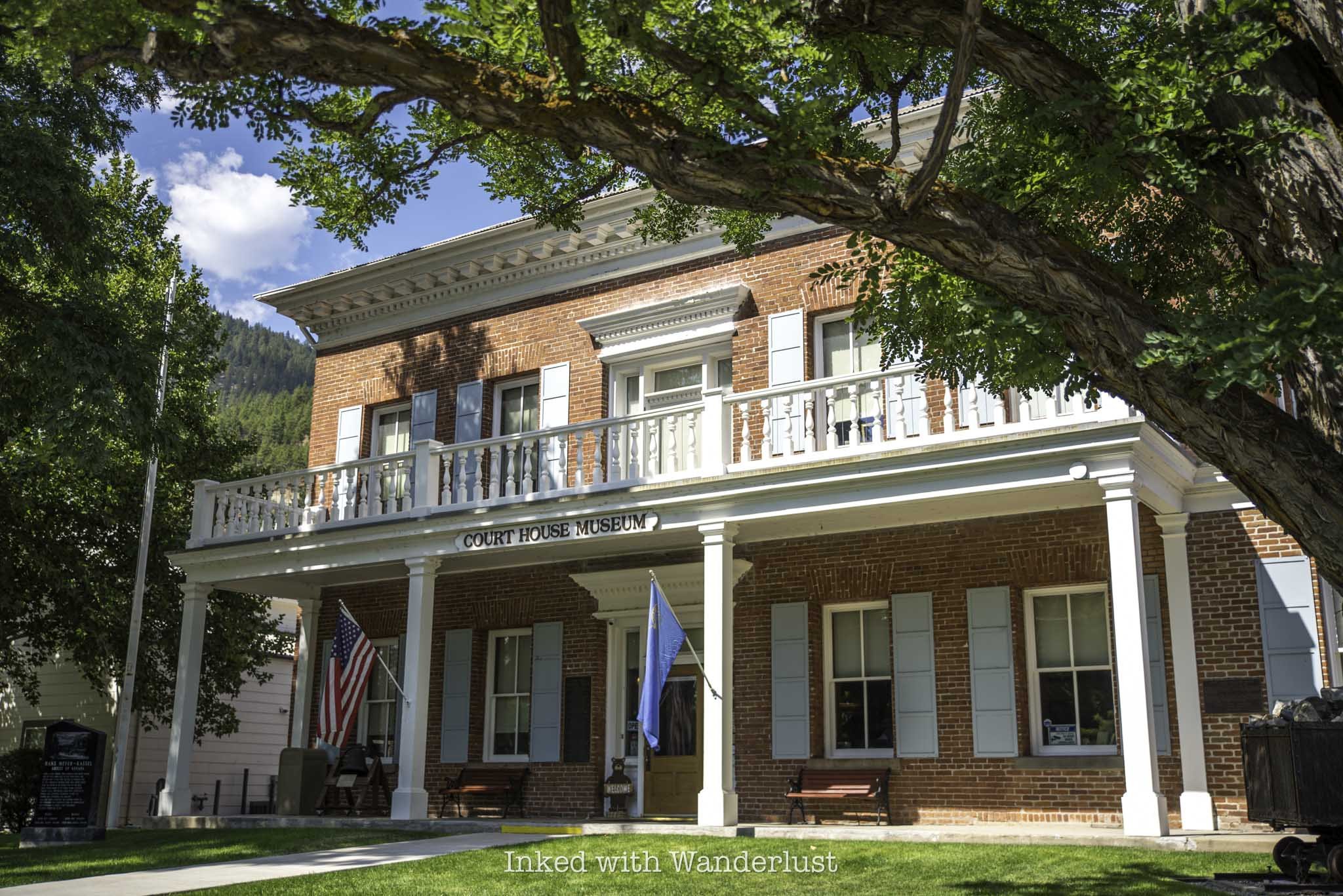Step Back in Time at the Genoa Courthouse Museum
Disclosure: This post contains affiliate links. If you make a purchase through these links, I may earn a small commission at no additional cost to you. I only recommend products or services that I believe will add value to my readers.
Located in the small, highly historic town of Genoa is the equally historic Genoa Courthouse Museum. This museum is packed with Genoa history, displaying the original courthouse with restored furniture, the ground-floor jail, a blacksmith shop, a Snowshoe Thompson exhibit, and more.
Considering most people visit Genoa in order to invoke the feeling of nostalgia, it would be criminal not to visit the museum. If you want to take it a step further, you could even retrace the steps of the, “blackest day in Nevada history”.
In 1897, the murderer of a local teamster met a violent end when an angry mob of locals took the man from his jail cell in the courthouse and marched him to a tree a quarter-mile away, where he was ultimately hung. Both the cell and tree involved in the hanging remain to this day.
With all of the history contained in this building, I believe it’s one of the best historical places in Nevada to visit. So what are the museum’s hours? How much does it cost to visit? What’s the parking situation like? I answer all of these questions and more in the post below. Let’s get into it.
Products I recommend bringing with you to Genoa…
Genoa Courthouse Museum Hours, Location, and Fees
As stated above, the museum is located in Genoa, which itself is located within Carson Valley, between the larger cities of Gardnerville and Carson City. From Gardnerville, it’s about 8.5 miles away. From Carson City, it’s just about 13 miles.
If you’re driving in on Jacks Valley Road from the north (Carson), you’ll arrive to the museum shortly after entering Genoa city limits. It’ll be on your right, across the street from Mormon Station. From the south on the same road, you’ll find it just after the one and only intersection in town on your left.
If you’re driving in from the highway on Genoa Lane, you’ll turn right at the stop sign at the intersection. The courthouse will be on your left shortly after turning. There isn’t much of any parking in front of the courthouse, but there’s plenty right across the street along the road.
One thing to keep in mind is the museum is only open seasonally, between the months of April and October. In those months, it’s open daily between the hours of 11am and 3pm. Occasionally, the museum offers docent led tours but more often than not, tours are self-guided.
I found the entry fees to be reasonable. They accept both cash and credit cards as payment. As of 2024, the fees are as follows:
$5.00 - Adults
$2.00 - Youth (there wasn’t a defining age cut-off for what’s considered “youth” posted)
Free - Kids aged 0 - 6
Genoa Courthouse Museum Tour (Ground Level)
As stated above, tours of the museum are largely self-guided, though they do offer docent led tours from time to time. If you’re interested in that, it’s best to contact the museum directly to inquire about docent tour schedules. Also, I will only give minor details about the exhibits as to not spoil your visit.
When my friend and I visited the museum we did the self-guided option, so that’s what this post will focus on. There are two levels to the museum, each featuring their own exhibits. You can start and end your tour however you wish, and even go another round if you wanted.
On the ground level are four rooms (not counting the bookstore) that feature multiple exhibits. The first two rooms, which are located directly next to the stairwell, feature a classroom exhibit and a set up of what the recorder’s office looked like. All of which contain artifacts that were used in each respective environment, including actual court case records and property deeds from the period.
An interesting feature of this museum is that almost none of the exhibits are roped off and you’re free to wonder about them. Of course, they do ask that you not touch anything but aside from that, there are very few restrictions. This is rare as at most museums, you have to stand behind a rope and view exhibits from a distance.
The next room displays many photos and artifacts of the Wa She Shu tribe, who inhabited the area near Lake Tahoe near the Nevada and California border, including what is now Genoa, prior to the arrival of white settlers. The most prevalent artifact are the many examples of hand-woven baskets and hand tools.
In the room behind this one is an example of a local blacksmith shop and the exhibit perhaps most people come here to see - the historic jail. The two cells and accompanying bathroom aren’t recreations. These are the actual cells that people were detained in.
It was one of these cells that Adam Uber, the man who killed teamster Hans Anderson in 1897, was kept in. In a fit of rage on November morning, an angry mob of locals stormed the courthouse, overtook the Sheriff and Undersheriff, marched Uber a quarter-mile away to a tree and hung him from it.
This would become known as the, “blackest day in Nevada history”. While the branch he was hung from was cut down, the tree still remains and is identified by a plaque. To get there, walk or drive down Jacks Valley Road and turn left onto Genoa Lane. The tree will be on your right and marked by the plaque pictured below. You can’t miss it.
This isn’t meant to glamorize what happened, as it’s an unfortunate part of the state’s history. In order to learn from it, though, it’s important to preserve sites such as this tree and these cells. To access the next floor, walk back into the bookstore area of the museum and head up the stairwell near where you paid to get in.
Genoa Courthouse Museum Tour (Second Level)
The main attraction in the upstairs portion of the museum is the courthouse. This is the actual room where trails took place and most of the displayed furniture is of the period, though most of them have been restored.
Much like the rooms downstairs, you’re free to walk about the courthouse, including the area where the attorneys and defendants used to sit. The only roped off area is behind the bench, where the judges would preside over trials.
The room directly across from the courthouse is an exhibit on John “Snowshoe” Thompson, who made regular trips over the Sierra Mountain Range to deliver the mail from Genoa to Placerville, California, using a pair of homemade, wooden skis.
*Note: You can see the actual skis he used in the museum at Mormon Station State Historic Park across the street
In this exhibit, the main draw is a recreation of his cabin, complete with actual furniture and other household items which belonged to him. On the walls, you’ll find letters written by him, photos, and a map showing the routes he would take when delivering the mail.
Other exhibits in the upstairs portion of the museum include the front panels of the Genoa post office counter and accompanying mail slots, both of which predate Nevada as a state. You’ll also see an example of what a child’s room looked like in Genoa’s early days, and one on George Washington Gale Ferris Jr - a Carson City native and inventor of the Ferris Wheel attraction.
As you can see, there is much more to this museum than just the jail and courthouse exhibits. There’s so much local history packed into this relatively small building, that you could literally spend hours looking around. If you ask me, it’s well worth the five bucks.
When you finish up at the museum, walk across the street and explore the historic Mormon Station State Park, the site of the first settlement in Nevada. Then, take a few minutes walk down Jacks Valley Lane to enjoy a drink at the oldest bar in Nevada, the Genoa Bar and Saloon. From there, head over to The Pink House for a delicious meal.
PROVERBS 16:9





































